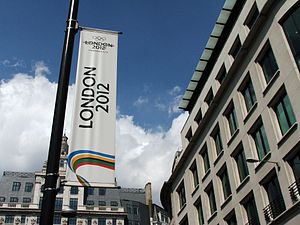
London Olympic Park. Source: Flickr @onehourleft
Following up on the series of posts on transportation investments in Olympic host cities, I thought it appropriate to explain what the transportation investments are for the 2012 Olympic Games. First, it’s important to note that transportation investments are legacy investments, most of these are long-term investments and will benefit Londoners for generations. The legacy investments in transportation cost a staggering £6.5 billion ($10.1 billion USD). These investments include the following:
Stratford Regional Station
Stratford Regional Station is a major connection point that links the London Underground’s Central and Jubilee Lines, the Docklands Light Railway, the London Overground North London Line and several National Rail Services. This station will be a gateway for the Olympic Games and to the Stratford area of East London. £125 million ($194 million USD) has been invested into the station in preparation for the Games. During the Games this station will serve 10 different rail routes, making it one of the most connected stations in all of London.
The high level platforms serve the London Overground North London line, London Underground Central Line, the DLR via Poplar and the National Rail services on the top-level platforms (see photo, left). The lower level platforms serve the Jubilee Line and DLR via Canning Town. In the future, Stratford Regional will also connect with Crossrail services.
London Overground
The East London line opened in May 2010 and has been incorporated into the London Overground system. The service links 21 stations from Dalston Junction in east London to West Croydon and Crystal Palace in the south. Four brand new step-free stations have been built and the existing stations have been fully refurbished.
Capacity and service frequency have also been increased on the London Overground’s North London line, which connects Richmond and Clapham Junction in south-west London to Stratford Regional via North London. The upgrade includes new signals, track and rolling stock, and longer platforms so the line can operate four car trains. The video below provides a pretty good idea of the investments made on the London Overground.
Stratford International Station
Stratford International Station is a mainline railway and DLR station located in the center of Olympic Park. It’s located on High Speed 1 between St. Pancras and Ebbsfleet International in the Stratford region. The DLR was extended from Canning Town north to provide a connection from Stratford International to the rest of the London public transport network.
During the Olympic Games this line will be used by the Javelin service, which will be able to transport thousands of passengers an hour. Service frequencies of eight trains per hour is planned between St Pancras and Ebbsfleet during the Olympic Games. Travel time to St. Pancras is 7 minutes.
Docklands Light Railway (DLR)
An extension of the DLR is from Canning Town to the new Stratford International station. It will stop at Stratford and West Ham stations as well as new DLR stations at Stratford International, Star Lane, Abbey Road, and Stratford High Street.
Another extension of the DLR is under the River Thames from King George V near London City Airport to Woolwich Arsenal station. This extension opened in January 2009. It provides a north–south link to the Olympic Park and Stratford area and offers better connections to East and South London. 55 new railcars have been ordered for the DLR, enabling it to run three car trains on its network.
London Underground
Capacity on the Jubilee line was increased by 17% following the addition of seven car trains in 2006. A new signaling system will increase capacity by a further 33% through faster more frequent services.
A new northern ticket hall opened at King’s Cross St. Pancras station in November 2009, providing a vital new link for passengers arriving on Eurostar services and National Rail services. Combined with the western ticket hall – which opened in 2006 – it has quadrupled the capacity of the station, cutting congestion and significantly improving accessibility.
Emirates Air Line
A cable car over the River Thames will be built with the sponsorship of Emirates air carrier. The £60 million ($93 million USD) project will link Greenwich Peninsula to the Royal Docks. The cable car could provide a crossing every 15 seconds carrying up to 2,500 passengers per hour in each direction, equivalent to the capacity of 50 buses.
Orient Way
To open land up for the Olympic Park, a large train storage yard depot used to store trains serving Liverpool Street Station during peak hours was relocated from the heart of the Olympic Park to a new 12-track facility at Orient Way to the northeast of Olympic Park.
Notes
Note how I have really only mentioned rail investments. That’s the beauty of the London Games is that there are virtually no permanent capital investments in the road network. Sure, there will be temporary park-and-ride facilities outside the M25, and there are miles of pedestrian and bike trails within and around Olympic Park, but virtually every major permanent capital investment is in rail. These transportation investments have been regenerating Stratford and the East London with new development, including one of the largest commercial developments in Europe, Stratford City.
This is, I believe, a positive legacy of hosting the Olympic Games. Increasing access and mobility to some of the poorest in the UK while providing jobs and a richer environment is a legacy worth having.














